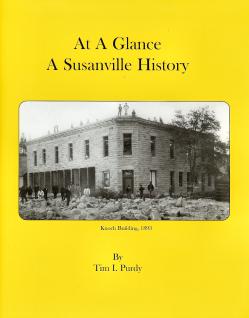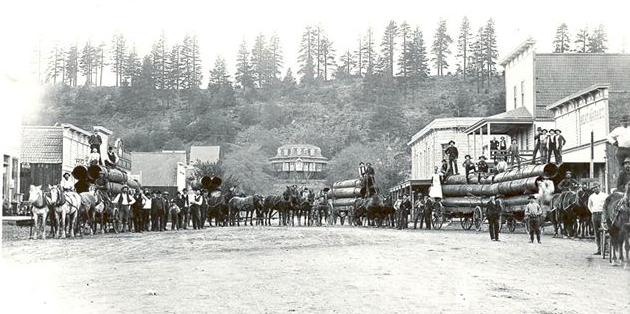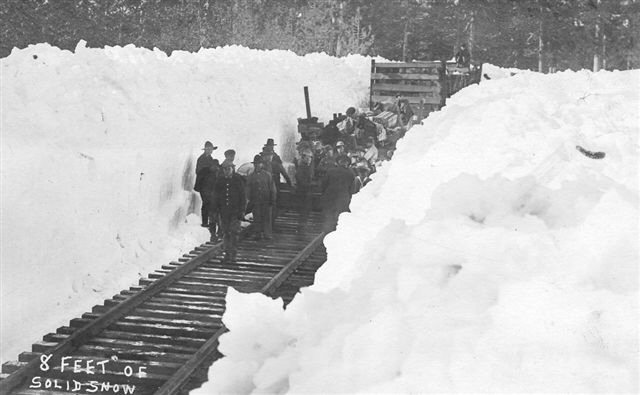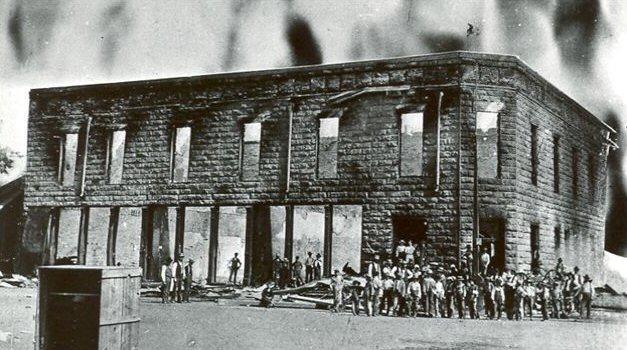
| HOME |
| Eagle Lake |
| Lassen Almanac |
| Susanville |
| Fruit Growers |
| Other Titles |
| Lake Almanor |
| Lassen High |
| Lassen VNP |
| Red River Lumber |
| Search |
| Archive |
| Research Services |
| Links |
Exploring Lassen County's Past and more . . .
|
At A Glance By Tim I. Purdy 8x11; 207 pages, illustrated, index, hardcover, ISBN: 0938373-22-6, Price $39.95 Susanville has undergone many changes since that fateful summer of 1854 when Isaac Roop and Company built a trading post on the Nobles Emigrant Trail there. This is a unique evolutionary history of how Susanville has come to be. There were two significant events to have the most profound impact-fire and the railroad. During the latter 1880s, fire was a persistent problem. In 1893, the town's entire business district was leveled by fire. Yet, its residents would endure several more blazes until 1900, when the took the matter under control to form the municipality of Susanville as a means to provide fire protection. Initially, after the City was created, it struggled to provide services, as it had no operating revenue and Lassen County did not help the situation. By the time the City was functioning, the railroad had arrived in 1913. In several years, E.V. Spencer's "Sleepy Hollow" as he called the community without a railroad, was transformed into a major lumber manufacturing center with the mills of Lassen Lumber & Box Company and Fruit Growers Supply Company. Years later, two more mills were established the Paul Bunyan Lumber Company and the Susanville Logging Company. In the 1950s, with the decline of the lumber industry eminent, the prison movement was established. The lumber industry brought prosperity to the region as witnessed by nearly a dozen housing subdivisions surrounding the community, as well as three new schools in three years! Yet, even before the railroad and the mills, Susanville's business district was going through its own transformation. The City was instrumental in its passage of controversial Ordinance No. 17 in 1902 that prohibited the construction of wooden buildings in the town's business district, as a fire preventive measure. This and other ordinances did not please certain factions in the City. The 1920s saw the City's first recall election of Trustees Breitwieser and Mathews concerning the paving the streets and cement for sidewalks. There was the underlying issue of gambling that these two men were in favor for as a means to finance City operations. Since the arrival of Prohibition the City lost one-quarter of its revenues from liquor licenses. While the 1920s roared, the 1930s were far from being dull. One of the pinnacle issues was that of sky high electric rates of the Republic Electric Company. The Lassen County Chamber of Commerce pushed the issue to form a public utility district-Lassen Municipal Utility District. The election for its creation and subsequent operation is a most interesting chapter in the City's history-after all, the City attempted to take over the Republic Electric Company at the same time. By the time Word War II arrived the issues of Lassen Municipal Utility District had been resolved, only to be replaced with new problems. The crime rate from the construction of the Sierra Army Depot at Herlong, forced the City to finally increase its police department, to three! The City Jail, on the other hand was woefully inadequate. The post was years brought with it a housing boom. This time too, fire placed another pivotal role in the development of the City. Those fires, in 1947, led to a Greater Susanville through numerous annexation efforts and now the City limits extended from Weatherlow Street all the way to Fairfield . There are several chapters devoted to other aspects of the community. One chapter provides a brief history of the churches and schools. Another examines a variety of recreational aspects as to how the residents amused themselves over the years. And finally a third chapter explores the extremes in weather the area witnessed such as the flood of 1938. This fact filled volume covers a lot of territory and interspersed is a lot of interesting trivia, such as the City's establishment of a speed limit of eight miles per hour in 1902, though the first automobile did not appear on the City's streets until 1903. Available from your local bookseller or direct from Lahontan Images, P.O. Box 1592 , Susanville , CA 96130 ($39.95 plus $3.95 shipping)
The Susanville Project Susanville’s first fifty years was on the troublesome side. In the 1860s, just as the town was beginning to flourish, outside events took its toll on the town. Between an economic depression and being bypassed by the Central Pacific Railroad crippled development. The railroad issue would linger on for decades, until finally in 1913, the rails of the Fernley & Lassen Railroad arrived in Susanville and a whole new era of commerce forever changed the community. A boomtown frenzy was created that kept going with the establishment of the lumber mills of the Lassen Lumber & Box Company and the Fruit Growers Supply Company. In the 1950s, witnessed a rapid decline in the lumber industry and thus the movement to establish a prison took hold.
One of the problems that plagued the town in its early years and would be catalyst for the town to incorporate as a municipality was—fire. However, Isaac N. Roop in his progressive nature did something special for the community he founded. Most people take the wide streets in the old section of town for granted. This was a novelty in frontier California and the West. Gold rush communities were dense due in part of their narrow streets. It was Roop’s belief that wide boulevards, not only enhance the physical layout of the town, but more importantly would work as a fire barrier. Roop’s particularly wide Main Street, for the most part always worked as a so-called fire barrier. In only one instance was the town’s entire business district leveled by fire.
It was the devastating fires of the 1890s that also changed the character of the town. Yet, it was the fire of June 6, 1900, that was the final proverbial straw that led to the incorporation of Susanville. On August 15, 1900, the residents of the proposed new town voted 61 to 20 in favor of incorporation and thus the City of Susanville was born. There were many struggles for the town in its infancy, especially collecting the lucrative liquor license tax—originally the main source of revenue for the town. In 1902, when the City passed Ordinance No. 17 prohibiting the construction of wooden frame buildings in the business district, that action did not sit well with a lot of folks. These are just a sampling of some of the topics explored in this fascinating volume of Susanville. Take for instance the technology of communications. In 1877, was the first time the town was connected to the outside world via a telegraph line.
The first residential telephone services were established in 1904, but long distance service did not arrive until 1911.
The first operators, by the way were:
Nina Turnbaugh, Lucille Pearce and Eva Lanigar, and their job titles then were “Hello Girls!” From time to time, this page will be updated, with progress on this project. If you have any comments on this topic, stories or photographs to share drop me a note at lahontan@citlink.net Tim I. Purdy |
Web Visits:
Last Updated: November 21, 2014
Report web site problems to Attn: Web Coordinator



